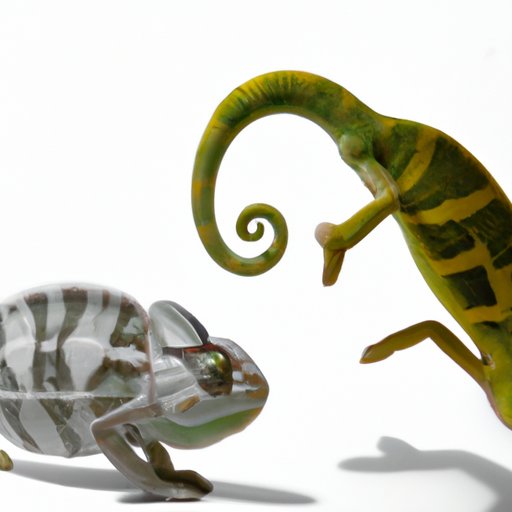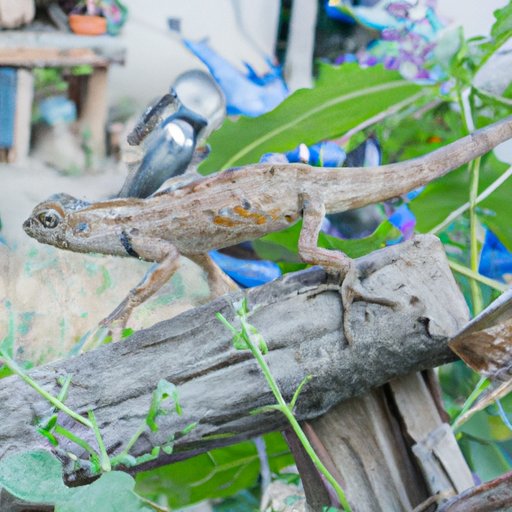Introduction
Chameleons are some of the most unique lizards in the world due to their ability to change color and their distinct physical features. With over 180 species, these lizards come in a variety of sizes and shapes. In this article, we explore how big chameleons can get and the factors that contribute to their size. We also examine the pros and cons of owning large and small chameleons and provide a guide to help you choose the right size chameleon for your home.
How Big Can a Chameleon Get?
The size of a chameleon depends on the species. Generally, they range from 2 inches (5 cm) to 24 inches (61 cm). The smallest species is Brookesia micra, which is found in Madagascar and measures only about 0.4 inches (1 cm) long. On the other end of the spectrum, the largest species is the Parson’s chameleon, which can grow up to 24 inches (61 cm).
What Are the Biggest Chameleons in the World?
The Parson’s chameleon (Calumma parsonii) is considered to be the largest species of chameleon. Found in Madagascar, this species can reach lengths of up to 24 inches (61 cm). Other large chameleon species include the Veiled chameleon (Chamaeleo calyptratus), which can reach lengths of up to 20 inches (50 cm); the Jackson’s chameleon (Trioceros jacksonii), which can reach lengths of up to 17 inches (43 cm); and the Panther chameleon (Furcifer pardalis), which can reach lengths of up to 14 inches (35 cm).

Exploring the Factors That Determine Chameleon Size
The size of a chameleon is determined by several factors, including genetics, environment, and diet. Genetics plays an important role in determining the size of a chameleon, as certain species tend to be larger than others. For example, the Parson’s chameleon is naturally larger than the Veiled chameleon. Environment is also an important factor, as chameleons living in areas with abundant resources tend to be larger than those living in harsher environments. Finally, diet plays a key role in determining a chameleon’s size. Chameleons that have access to a high-quality diet tend to be larger than those that do not.

Pros and Cons of Owning Large vs. Small Chameleons
Owners of larger chameleons may find that their pet is easier to handle, as they are less likely to escape and more tolerant of being handled. However, larger chameleons also require more space and special lighting. Owners of smaller chameleons may find that their pet is easier to care for, as they generally require less space and fewer resources. However, they are also more prone to escaping and more fragile when handled.
A Guide to Choosing the Right Size Chameleon for Your Home
When selecting a chameleon, consider the size of the species and its natural habitat. For example, if you live in a tropical climate, you may want to select a species native to the area, such as the Panther chameleon or the Jackson’s chameleon. If you live in a temperate climate, you may want to select a species native to the area, such as the Veiled chameleon. Additionally, consider the size of your home and the resources available. Larger chameleons require more space and resources, so make sure you have the appropriate setup before purchasing one. Finally, research the diet requirements of each species to ensure you can provide your pet with the nutrition it needs for optimal health.
Conclusion
Chameleons come in a variety of sizes, ranging from the smallest Brookesia micra at 0.4 inches (1 cm) to the largest Parson’s chameleon at 24 inches (61 cm). The size of a chameleon is determined by several factors, including genetics, environment, and diet. When selecting a chameleon, consider the size of the species and its natural habitat, the size of your home, and the resources available. Owning large and small chameleons both have their pros and cons, so make sure you do your research before making a decision.
(Note: Is this article not meeting your expectations? Do you have knowledge or insights to share? Unlock new opportunities and expand your reach by joining our authors team. Click Registration to join us and share your expertise with our readers.)
